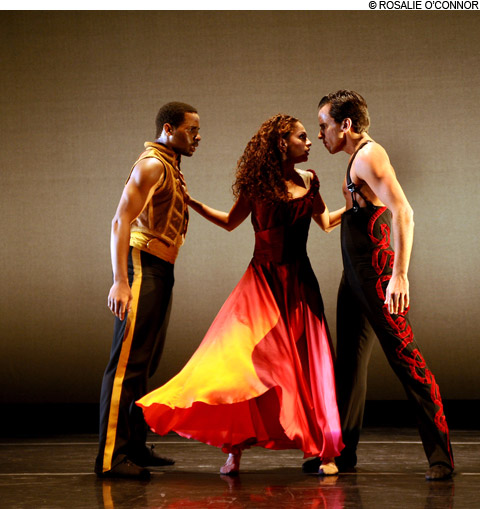
SIGN LANGUAGE The costumes were more impressive than the choreography. |
All three dances presented by Ballet Hispanico at the Cutler Majestic last weekend depended heavily on costume effects to convey their messages. They all leaned on recorded songs and rhythms with a Latin flavor, and they all claimed to examine the culture of the great Afro-Latino diaspora that has surged across the Western Hemisphere for more than half a century. But signs don't always translate into dance, and Ballet Hispanico's program was pure choreographic marshmallow.Eduardo Vilaro had worked with Ballet Hispanico as a dancer and administrator before taking over as artistic director from retiring company founder Tina Ramirez in 2009. He has roots in Cuba. His dance Asuka celebrates the Cuban singer Celia Cruz, whose records, broadcast on Spanish-language radio stations, brought salsa into American culture along with the Cuban immigrants themselves.
Jessica Alejandra Wyatt opened and closed the dance as a stand-in for Cruz, with powerful, histrionic solos. I was interested to learn that she's the daughter of two dancers from the early days of Dance Theatre of Harlem, Joe Wyatt and the lamented, wonderful Elena Carter.
Nothing that Jessica Wyatt did reflected onto the duets and chorus work of the other 10 dancers, who moved around energetically in a bland, Alvin Aileyish idiom of generalized yearning. There were several duets, each one a little bit different from the others to suggest different types of relationships. Some were same-sex matchups. Some were "serious," some were contentious, some goofy.
All the women, including Wyatt, were made to wear candy-colored mini-dresses with flaring skirts that looked like boudoir lampshades edged with fur. At the end Wyatt, who had been offstage during most of the dance, reappeared in a minidress made of sequins. I guess this attire represented her ascendancy to stardom. She looked unhappy, but after a brief encounter with one of the men — he hugged her passionately, then retreated — she resigned herself to a lonely life at the top.
Espiritu Vivo had the formal clarity we expect of its choreographer, Ronald K. Brown. To four songs by Afro-Peruvian singer Susana Baca, the five women and three men progressed from "The News" to "Prayer," "Spring," and "New Day," a sort of four-step grief program. First they trudged around with their heads sunken into the hoods of their jackets and dresses. The men knelt and seemed to wipe the floor with both hands. Finally the hoods came off, and the limited movement vocabulary of contractions, undulations, and pirouettes in attitude coalesced into an exultant procession.
The program closer, Mad'moiselle, by Annabelle Lopez Ochoa, featured a chorus of women and at least one man in red Dynel wigs, black corselettes, and red accessories — elbow-length gloves, long trailing boas, bustles. Assorted serenades to people called Maria were mixed with shouts and conversation. There was a diva in this one too, in knee-length red platform boots with spike heels. She slunk in and out, making a final entrance adorned with towering puffs of red fabric. She looked like a religious deity. The sound-track played Gounod's "Ave Maria." There was probably some gender-play in this piece too — or anti-gender play. Everyone except the goddess was dancing more or less topless at the end.
Celebrity Series takes credit for bringing this show to Boston. New York–based Ballet Hispanico may be an established company, but the choreography and the dancing were underdone and uninspiring, even for the mainstream audience. In a more challenging program, Ron Brown's dance might have been more effective. Plodding between the other two items, it sank into the marsh.